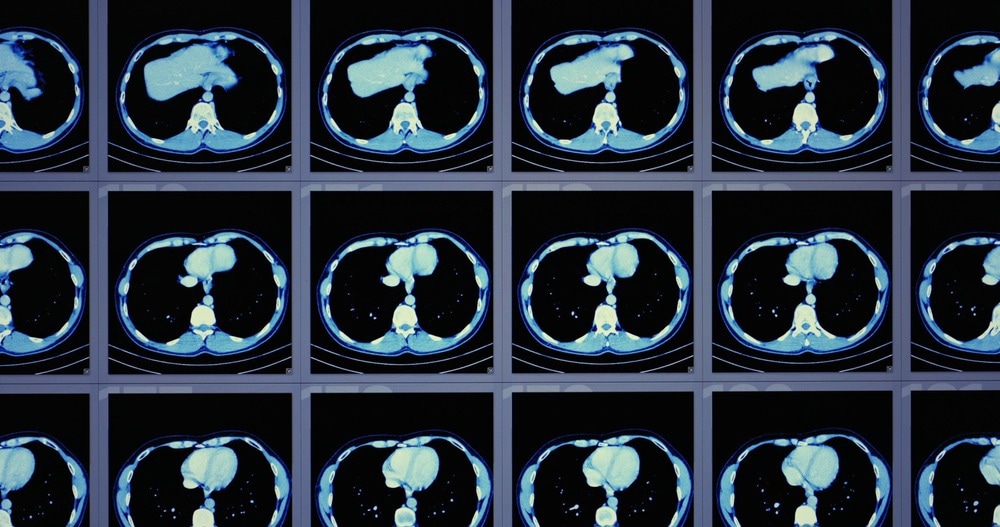A research group has proposed a new method to produce more detailed CT scan images of patients at the Biochemistry and Biophysics Center of the National Institutes of Health in Bethesda, Maryland, US. The innovation, led by Professor. Han Wen, implements a hybrid imaging device with a low-profile photon-counting detector insert and a conventional computed tomography (CT) scanner. Details of the study can be found in the latest issue of Tomography.

Study: Online Geometric Calibration of a Hybrid CT System for Ultrahigh-Resolution Imaging. Image Credit: SvedOliver/Shutterstock.com
Computer and X-rays are used in computerized tomography (CT) scans to provide in-depth images of the inside of the human body. CAT scans or computed tomography scans are other names for CT scans. Internal organs, blood arteries, bones, and other body structures can all be seen in great detail in CT scans. They are utilized to:
- Identify medical conditions
- Guide medical care and direct future research
- Monitor the evolution of a health condition
The focus spot penumbra typically limits current clinical scanners' image resolution. The outermost portion of images produced by CT scanners has a shadow cast by an opaque partially shaded region of the object. This is due to the finite focal point size that results from high amounts of X-ray power to achieve quick scan times.
Prof. Wen’s team devised a hybrid CT scanner that combines a conventional CT scanner with a second, low-profile photon-counting detector (CDI) positioned on the patient's bed and in contact with their chest. Due to the CDI's proximity to the patient's body, the X-ray source’s penumbra is reduced on the CDI, allowing for ultrahigh-resolution imaging in a small area in front of the CDI.
Online Calibration
Two critical abilities that a CT scanner should facilitate are the capacity to precisely integrate the CDI and CT scanner-reconstructed volumes and tomosynthesis - a type of 3D mammogram- of the CDI data. If this information is inaccurate, the CDI pictures will exhibit misalignment artifacts. This leads to discrepancies between the spatial positions of features in the CDI images and the CT images.
Online calibration is required for each scan to determine the CDI's location and orientation, depending on the patient's weight distribution and position on the bed.
While several online and offline calibration techniques have been developed and applied in the past, they have encountered significant drawbacks described in the report. In the current study, a new hybrid technique has been formulated. It is an online method with phantom-based technique traits.
Experimental Details
A low-profile photon-counting detector served as the CDI for the hybrid system, which was housed inside a commercial clinical CT scanner. The device can provide 2000 frames per second of data acquisition at an energy limit of 25 keV. Using the light indicator positioned outside the system, the CDI data collection began simultaneously as the CT scanner turned on its X-ray beam. The CT scanner's commercial software used the pre-set chest CT setting to produce the images.
Seven tungsten carbide beads with a 1 mm diameter served as fiducial markers. They were connected straight to a plastic strip wrapped around the phantom's exterior.
The orientation and position of the CDI in the world coordinate system of the CT scanner, as well as the angle of the X-ray focusing spot around its circular course at each time point of the scan, are the geometric parameters that need to be determined. The "true" places for aligning the CDI's reconstructed volume were determined via fiducial marker positions. The intensity thresholding and center-of-mass computations were performed in the same manner as with the CT images to determine the locations of markers in the CDI's reconstructed volume.
Two-dimensional (2D) locations of tiny vascular structures from CDI and CT images were compared in several image slices spanning the reconstructions to further quantify alignment.
Results and Outlook
The method devised by Prof. Wen’s group combines image-based iterative optimization and phantom-based calibration. The approach identified the geometric parameters of the system on a per-scan basis, which was confirmed by the fiducial marker and blood vessel alignment.
The approach reduced the misalignment between the CDI and CT images by 65%, to between 0.1 and 0.2 mm, starting from an initial estimate of the geometric parameters based on the presence of the CDI detector in the CT images. Given that the two datasets contain complementing information, the combined image from the two datasets gave a more accurate representation of the object.
Further advancements will reduce the overall computation time for this calibration approach. Each patient scan will require geometric calibration using an online method, and it would benefit from cutting the computation time to just a few seconds.
Additional code optimization and more powerful parallel processing are also necessary for achieving optimal results. Refined reconstruction algorithms are required to decrease image artifacts in the CDI's reconstruction to improve alignment outcomes.
References
King, Dakota H., Muyang Wang, Eric E. Bennett, Dumitru Mazilu, Marcus Y. Chen, and Han Wen. (2022) Online Geometric Calibration of a Hybrid CT System for Ultrahigh-Resolution Imaging. Tomography 8, no. 5: 2547-2555. https://www.mdpi.com/2379-139X/8/5/212
Disclaimer: The views expressed here are those of the author expressed in their private capacity and do not necessarily represent the views of AZoM.com Limited T/A AZoNetwork the owner and operator of this website. This disclaimer forms part of the Terms and conditions of use of this website.